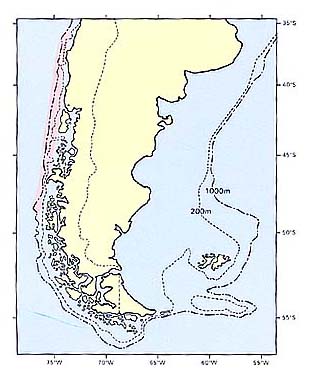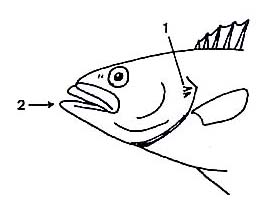スズキ科
- HOME
- デジタル図鑑
- パタゴニア海域の重要水族
- 硬骨魚綱 スズキ目
- スズキ科
スズキ科(Percichthyidae)

69 ニュージーランドオオハタ(Nyuuziirando-oohata)
Polyprion oxygeneios (Schneider, 1801)
Hapuku, Grouper, Whapuku (NZ.)
特 徴:
背鰭9~12,12軟条,臀鰭3棘,7~9軟条,胸鰭17~18軟条,腹鰭1棘,5軟条,鰓耙数0+8=8,鰓条骨数7,側線鱗数120~128。頭長は体長の37.3~38.4%,眼径は5.2~5.6%,体高は12.0~13.3%,吻長は11.7~12.5%,両眼間隔は10.5~11.0%,上顎長は16.7~17.9%,尾柄高は9.1~10.2%,胸鰭長は16.6~17.0%,腹鰭長は17.2~18.9%,第1背鰭高は9.6~10.0%,第2背鰭高は12.0~13.3%,臀鰭高は11.1~12.5%。体高は高く,側扁する,体長は体高の3.6~3.9倍。頭は縦扁し,著しく大きく,体長は頭長の2.5~2.8倍。口は大きく,上顎後端は眼の後縁下にほぼ達する。下顎は上顎より前方に突出する。両顎と鋤骨に微小な円鋤歯からなる歯帯が発達する。口蓋骨には絨毛状歯帯がある。下顎後端は幅広く,その幅は肉質眼窩径にほぼ等しい。吻は尖り,かなり長く,頭長は吻長の3.1~3.3倍。眼は中庸で,頭長は眼径の7.1~7.7倍。一対の鼻孔はお互いに相接近し,吻端より眼の前縁に近く,前鼻孔は円形で周囲に低い皮弁を備え,後鼻孔は卵円形で皮弁を備えない。前鰓蓋骨縁は鋸歯状。鰓耙は短く頑丈で,内側に小棘を備える。擬鰓がある。背鰭,臀鰭,腹鰭の棘は極めて強い。主鰓蓋骨に2棘があり,下の棘は前方に強い隆起を有し,上の棘は隆起を有さない。胸鰭は丸味を帯び,短く頭長は胸鰭長の2.2~2.5倍。腹鰭は胸鰭よりわずかに長い。尾鰭後縁はほぼ截形を呈し,尾柄高は高い。頭部,体部,背鰭を除く各鰭の基底に小櫛鱗が分布する。側線は単線で,前半部は湾曲し,後半部はほぼ直線で,全体として背縁に近いところを走る。
分 布:
チリ パタゴニア;ニュージーランドにも分布する。
備 考:
Bahamonde and Pequeño (1975)はチリで本種の代わりにPolyprion yanezi de Buenを認めている。
(中村 泉)
Material examined:
3 from Chile (506.0-566.6 mm SL), FAKU CP 175, 429, 584.
Description:
D Ⅸ-ⅩⅡ, 12; A Ⅲ, 7-9; P1 17-18; P2 Ⅰ, 5; GR 0+8=8; BR 7; LLS 120-128. HL 37.3-38.4% of SL; ED 5.2-5.6; BD 12.0-13.3; SN 11.7-12.5; IO 10.5-11.0; UJ 16.7-17.9; CP 9.1-10.2; P1L 16.6-17.0; P2L 17.2-18.9; D1H 9.6-10.0; D2H 12.0-13.3; AH 11.1-12.5.
Body deep, compressed, body depth 3.6-3.9 times in SL. Head depressed, extremely large, 2.5-2.8 in SL. Mouth large, posterior margin of upper jaw nearly reaching to below posterior margin of eye. Lower jaw extending anterior to upper jaw. Fine conical teeth in bands on both jaws and vomer. Villiform teeth in band on palatines. Posterior margin of upper jaw wide, its width about equal to fleshy orbit. Snout sharp and fairly long, its length 3.1-3.3 times in head. Eye moderate in size, its diameter 7.1-7.7 times in head. Nostrils large, situated closely each other, both nearer to anterior margin of eye than to tip of snout; anterior nostril circular with a low flap around and posterior nostril oval without flap. Posterior margin of preopercle serrated, serrations at angle larger. Posterior margins of opercle and subopercle finely serrated partly. Gill-rakers short and stout with fine spines inside. Pseudobranchiae present. Spines of dorsal, anal and pelvic fins very srtong. Two small spines on opercle; lower spine with a strong ridge anteriorly and upper spine without a ridge. Pectoral fin round, small, its length 2.2-2.5 times in head. Pelvic fin long, slightly longer than pectoral fin. Caudal fin slightly truncate with deep caudal peduncle. Head, body and bases of fins except first dorsal fin covered with small ctenoid scales. Lateral line gently curved anteriorly and nearly straight posteriorly, running nearer to dorsal profile.
Distribution:
Chilean Patagonia.
Remarks:
Bahamonde and Pequeño (1975) recorded Polyprion yanezi de Buen in Chile, instead of this species.
(Izumi NAKAMURA)

Distribution of Polyprion oxygeneios in Patagonia.

Head with opercular spines (1) and projected lower jaw (2).
- 1
- 2